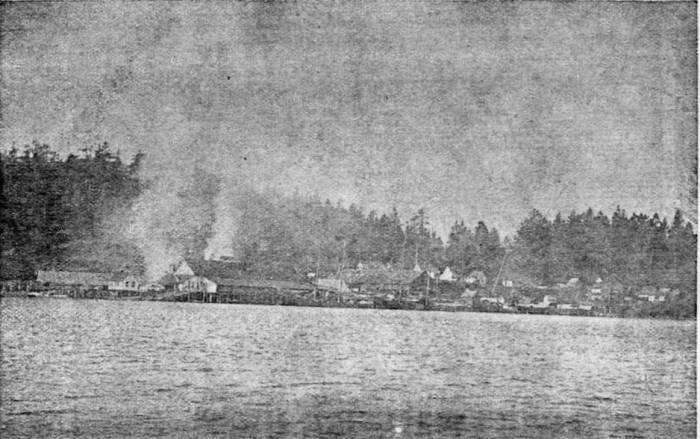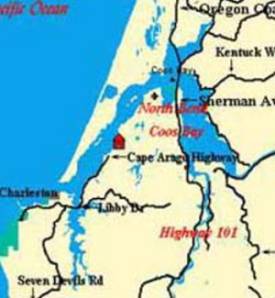Lockhart’s property was acquired by A. M. Simpson.
Over the next two years Simpson established first a sawmill and then a
shipyard. Simpson lived in San Francisco and operated his businesses from
there. His brother, Captain Robert Simpson, was the first superintendent of
the saw mill.
At first the lumber was shipped to San Francisco for use there. But Simpson
recognized that there was a market world wide for both the lumber and ships,
not only to haul the lumber but to carry other types of cargo as well. Thus
the Sipson Brothers fleet of ships and sawmill business continued to grow
during the latter half of the 1800’s.
When Peter Jepson arrived in North Bend in 1861 to work in the sawmill, the
business was barely five years old. This was a company town. The Simpsons
provided room and board for their employees. This description is given of
those days. "Pioneering and providing food for a logging and sawmill crew in
a new country presented a problem for the brothers Simpson....'The company
kept a boarding house for the workmen at Old Town....and at times they had
the most palatable table fineries. Elk, deer, fish, and ducks, were common,
and in season the meats were served at least once a week. The company
engaged regularly for many years, hunters whose business it was to furnish
meat for the boarders. These would bring in elk from across the bay, ducks
from Pony inlet, and the boarders sometimes thought game food coming too
often. The plan, however, at times was a necessity, for provision ships from
San Francisco frequently met long delays and provisions became scarce.'"
A new mill superintendent, Mr. Merchant, had been hired by the Simpsons
shortly before Peter arrived. This account is given of his arrival: “When
Mr. Merchant arrived at North Bend, in 1860, to take charge of Mr. Simpson's
business, before he stepped on shore from the vessel, he noticed someone
coming away from the store with a bottle in his hand. He inquired what the
meaning of it was and was soon informed that the store retailed whisky to
the men. Mr. Merchant, addressing the captain stated if that was the case he
would want passage back to San Francisco; however, Mr. Simpson informed him
that if he thought he could run the business without liquor he could do so.
Mr. Merchant then commenced operations, although he had great opposition and
was even threatened with violence from the men he conquered and North Bend
has been a strictly temperance town ever since, and as soon as Mr. Simpson
saw the beneficial results arising from Mr. Merchant's policy, he adopted
the same prohibiting rules at the other half dozen large industries he has
along the Pacific coast."
Peter stayed until about 1868 when he went back home to Sweden and found a
bride. A description of the area was written shortly before he left and
provides a word picture of where he was living and what kind of home to
which he brought Lovisa. The description begins with the author having just
entered Coos Bay from the Pacific.
"We will now proceed up the channel, and six miles from the bar we shall
pass the town of Empire City on the right. Here the pioneer first planted
civilization. Six miles more brings us on a rightward turn to North Bend,
where Lockhart first located a home in the wilderness, and here a
magnificent view bursts upon our vision, for we have entered the upper bay
and the evergreen hills encloses thousands of acres of flat marshy lands,
seven-eights of which are submerged at every flood of the tide. To the south
there is a high range called the Blue mountain; this contains an
inexhautible [sic] body of coal which crops out in all directions. With the
view from North Bend the bay seems to extend to the foot of the mountain but
there are several extensive streams to ascend.…
The Jepsons stayed until 1876. This is what North Bend looked like about the
time they left.

“The town consists--besides the mill and ship
yard--of elegant dwellings and
cosy cottages; one store being the only place of trade. The whole area is
owned by the Simpsons, who built the mill, and they have strenuously
forbidden the sale of intoxicants or immoral practices on the premises."
Sources
1870 Census, Book-Early U S Census of Southwest Coastal Counties of Oregon.
A Century of Coos & Curry: History of
Southwest Oregon by Emil R. Peterson and Alfred Powers, 1952, p 428
(Family History Library, Salt Lake City, Utah, call # 97952/H2P)
Inventory of the County Archives of Oregon, No. 6 Coos Bay
(Coquille), prepared by the Oregon Historical Records Survey Service
Division, Works Projects Administration, Portland, Oregon, May, 1942 (Family
History Library, Salt Lake City, Utah, call # 979/523/A3h/1321454t.2)


